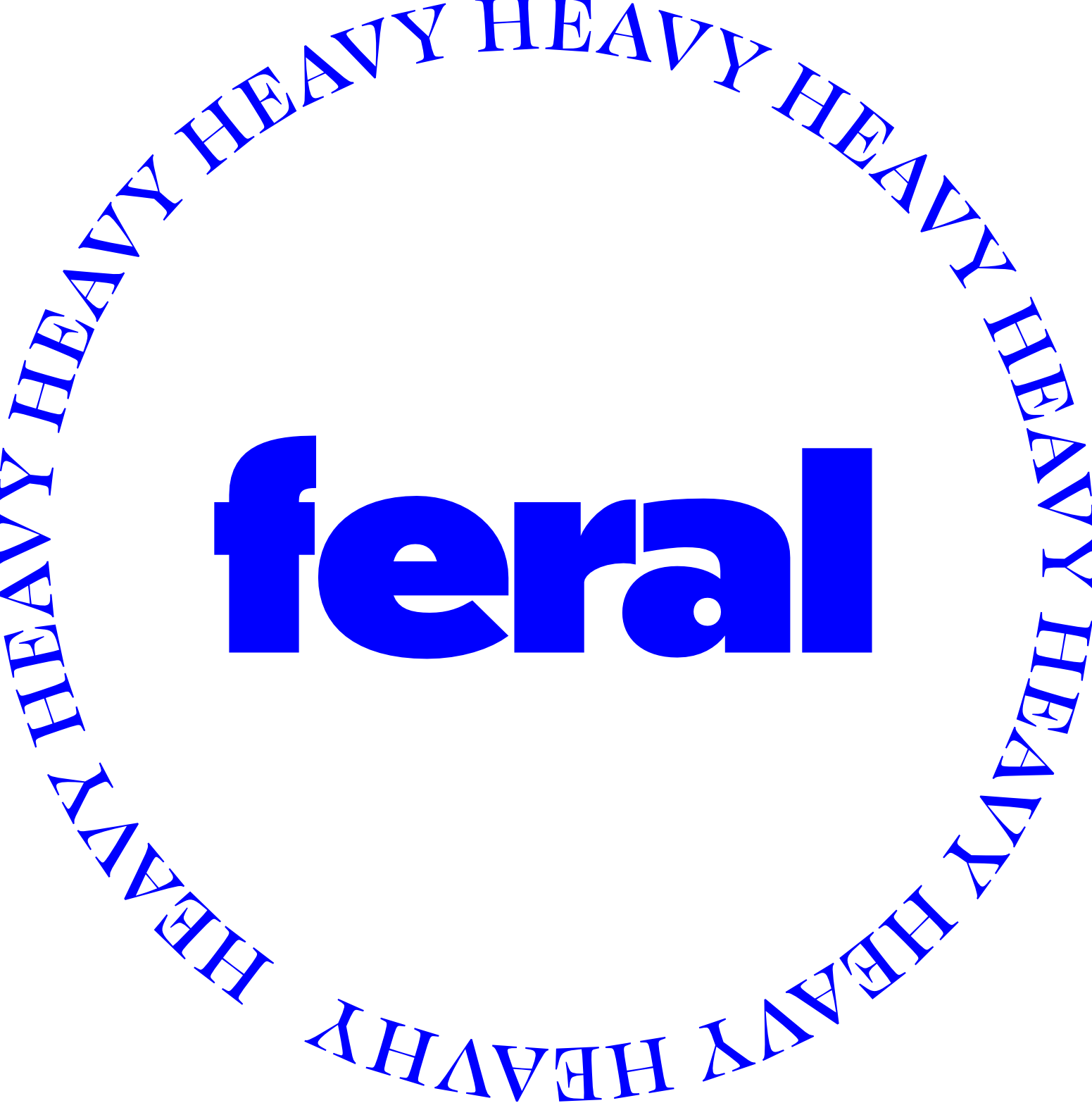



Collage Atrworks by MENLAYERS
Using pages from Heavy Feral Vol. 1
Words by Steve Marais
MENLAYERS X HEAVY FERAL EXCLUSIVE
Benjamin Menlayers doesn’t do singles. He prefers a layered approach. He does it for himself, not for the feed, and keeps his hands on paper because print still has a pulse. We gave him a stack of Heavy Feral vol. 1 and a week later he’d shredded, taped, scanned, and re-birthed eighteen – yes, eighteen!! – new works.

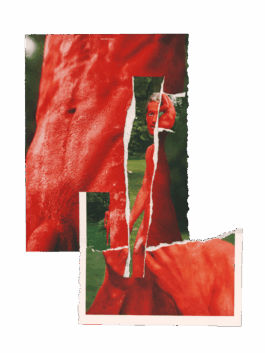
His ethos is simple yet intimate: care, surrender, reciprocity. For him, accidents become solutions; ageing shapes his selfhood. “I’m not worried about what people think or what people are running after,” he says, allowing acceptance to drive his process. If aliens land tomorrow, he’d open the door and “let them get inside me.” Fair enough, count us in.
Steve: Hey Benjamin. I have some fun questions for you.
Benjamin: That’s fine. I don’t have any secrets.
Steve: Careful! Let’s start with a small introduction. Who are you today?
Benjamin: Wow, huge question. Who am I today? There’s stuff on the internet; you can Google it. But who am I today? I’m becoming more and more myself. That’s what I feel right now. I’m becoming who I am in depth. I’m not worried about what people think or what people are running after. I’m doing my things and focusing on what means something to me.
Steve: And who are you as an artist? What do you do?
Benjamin: I do photography, collages, collaborations; lots. I’m trying to expand right now, but I can’t talk about it yet. I’m cooking new things, that’s it.

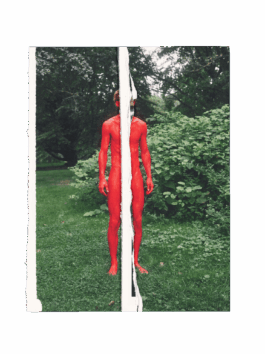
Steve: Exciting! Then let’s talk about the collages you made for Heavy Feral. Can you tell me about the process?
Benjamin: You sent me two or three magazines, I think. I went through them and read them. And then I destroyed them.
Steve: I can send you another one.
Benjamin: I still have some pages, don’t worry. I took the time to understand what I had in my mind and in my hands. Sometimes you have to switch off your brain and be aware of when you shouldn’t see or shouldn’t do; just let go. I spontaneously tore them apart and suddenly pieces came together. It was obvious to me. I don’t know why or how; it just happened. It was a full week working on your collages. In the end there were more than 18 artworks.
Steve: More than 18! Productive.
Benjamin: And then I always let them “sleep” a few days — three, four days — and come back to finalise them. That’s when my personal archives came in. As a creative person, I had to add some of my own DNA.
Steve: Exactly; your vision, style, flavour.
Benjamin: That’s what I did. It was really fun to see how it all came together.

Steve: They’re brilliant, complex, sexy! I love them. Let’s expand on your practice. What’s something about your work that no one asks but you wish they would?
Benjamin: Good question. “Why are you doing this?” is something I ask myself all the time.
Steve: Interesting… Expand on that.
Benjamin: When you confront yourself with your “devils”, however you call them, it’s the strongest energy you can channel. It’s interesting to go there. For me, it’s not just enjoyment. There’s a sort of goal. A natural call. I feel very often when I work on pictures or collages, I’m out of myself. A disconnection, but I’m going deep down without thinking.
Steve: Like a meditation.
Benjamin: Kind of.
Steve: If I followed you around for one day, what would I see?
Benjamin: Too many things. It depends on the day. If it’s a creative day: a photo shoot; collecting images; buying new books; going to exhibitions; mixing it all; diving into images; constantly repeating. Often with me there are bridges. Things that come back and back; circles. Even if I take another path, it comes back again.
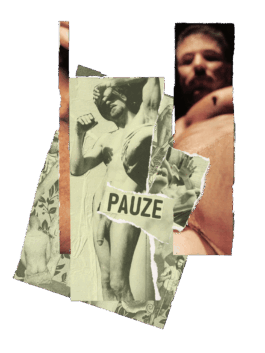

Steve: What’s the first thing you do when you wake up?
Benjamin: I take my time in the morning. I need 20 minutes or more to wake up. I can’t go from zero to 100 or I’ll be in a bad mood. After that I can do whatever.
Steve: What part of your work comes naturally, and what part feels like hard work?
Benjamin: What’s not natural is what I can’t control and don’t want to control. In a photo shoot, collaboration is organised and discussed with the model beforehand. But on the day, what the model brings, I just accept it – whatever it is. That’s what collaboration means. They give you a sort of “lâcher-prise” (free pass), and that’s your ticket. If you don’t do that dance, it doesn’t work.
Steve: That also comes with experience, I think.
Benjamin: And respect for people.
Steve: When I was younger I had precise ideas and tried to force it, but you can’t make something become what it’s not. You have to let it be.
Benjamin: I try to never force things. Back when I was working in fashion, I watched so many creatives do that, and it wasn’t healthy for them. I never wanted to be like that. I remember my first photo shoot here at my atelier. When the dancer was performing, an image I was dreaming just happened. I started crying! He was shocked. I said, “I think we can stop. You gave me what I didn’t even expect.” That’s why letting go is so important; otherwise you become a control freak.
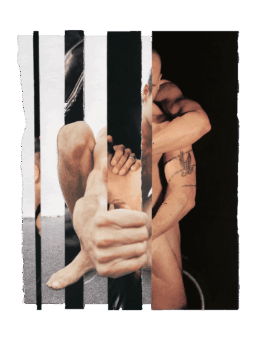

Steve: Do you need aesthetic stimulation to work? Like, do you need the right music, the right light, the right amount of, I don’t know, nakedness?!
Benjamin: Not if I plan it. But when I put myself in those “let go” shoes, I open a space to the collaborators. There’s freedom. That mixes our energy, not only mine. Yes, I invite them into my world, but they bring something specific and unique. That’s what matters.
Steve: Beautiful, yeah. That’s lovely. Do you create for an audience or for yourself?
Benjamin: For myself, for sure. When we talk about “audience”, we mean the platforms we use on the net. And I think all of them are reaching a point where I don’t know if it’s healthy for creative people anymore.
Steve: I feel the same. If I’m not mistaken, I think I found you on Bluesky. I don’t even use it anymore.
Benjamin: I still do, but I don’t really like it.
Steve: We’re such slaves to algorithms. I can’t take it seriously anymore.
Benjamin: Me neither.
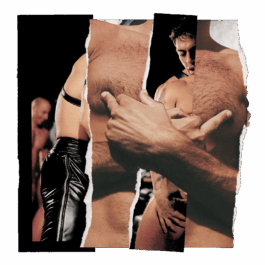
Steve: Then let’s not even go there. Next question. If the aliens landed and they go, “eep eep, what is this?”, how would you explain your work to them?
Benjamin: I don’t think I’d use words.
Steve: Oh! Would you let them touch you?
Benjamin: Yes, but not in a sexual way. I’d want them to get inside me, to understand how I function. Communication is about senses. We have five. I don’t know how many they have, but I’d let them get into it, and into me.
Steve: Wow. That’s profound! Do you think sex and creativity come from the same place?
Benjamin: I’m actually reading about it now, still debating. For different things, yes; for others, no. I think they are two pools that are connected, but not the same.
Steve: Like a river between two oceans?
Benjamin: Yeah, exactly. I think as a creative person, especially when collaborating with others, it’s like when you make love: you take care of each other, share, let go. That relationship mixes the two universes. But there’s no expectation of gratification. It just comes naturally. You “abandon”, but in a poetic way. Sometimes you meet someone who becomes a muse. That’s even higher, more powerful; it sweeps you from the floor.
Steve: Nicely put! Would you rather have multiple orgasms or one really intense one?
Benjamin: Multiple, because I’m very productive. Even as a photographer, I can’t do one perfect picture. We all know many photographers who take one shot and that’s it; I’m not in that group.
Steve: Me neither.
Benjamin: I have to create a narrative with multiple images to bring someone into the universe I’m creating. So, multiple orgasms for me, please!
Steve: When you select images to print or exhibit, do you exhibit series, or standalone images?
Benjamin: Always by series. The first time I encountered the work of Muybridge, I understood what I was looking for: from objects, animals, human beings — the movement. You can’t prove movement with one image; you need the series. That’s where I connect the dots to get one gaze, one movement, one emotion.
Steve: One sequence of events. I also work like this. Sometimes one image screams “pick me”, but I never create with that one image in mind. It’s a succession of things.
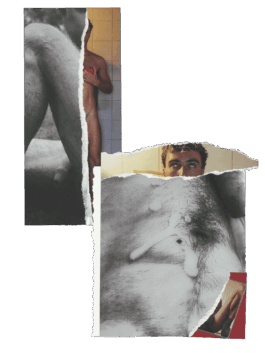
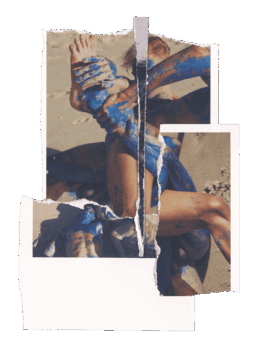
Steve: Would you rather live forever at 25 or 60?
Benjamin: 60. I’m not that kind of queer person who thinks youth is everything; I never felt that way. You’re more yourself when you’re older. When you’re young, you don’t think, and you don’t have to. I’m glad people like us grew up when print was still alive. We had influences on pages we flipped as young people. Nowadays they exist in a lesser format; a whole generation doesn’t get exposed in the same way. Every generation has good and bad; I’m no one to judge. But recently a young model came to me and said, “I want to collaborate because I can feel the paper in your work.” I was like, what? So across generations it’s still there; you just have to reach out to the good ones.
Steve: It’ll make a comeback.
Benjamin: That’s why we need to keep printing and talking, meeting new people. There are many good ones. We have to stay curious; that’s the most important, and the tricky part. So if I had to pick, I’d prefer to be conscious.
Steve: Anything you’d like to add?
Benjamin: No. It’s your project. Today I’m the one to let go.

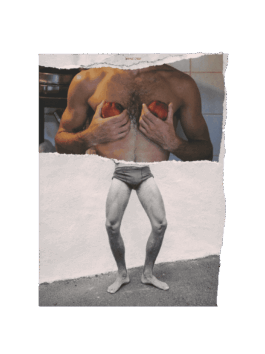
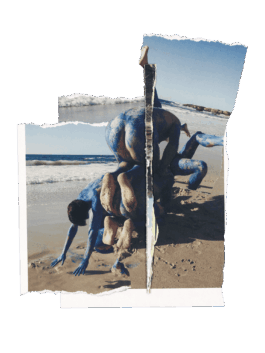

MENLAYERS is an artist dedicated to and fascinated by male iconography, photography, nudity, still-life and queer graphics from the 1970s and 1980s. The artistic alter ego behind MENLAYERS is Benjamin Edeline.


Collage Atrworks by MENLAYERS
Using pages from Heavy Feral Vol. 1
Words by Steve Marais
MENLAYERS X HEAVY FERAL EXCLUSIVE
Benjamin Menlayers doesn’t do singles. He prefers a layered approach. He does it for himself, not for the feed, and keeps his hands on paper because print still has a pulse. We gave him a stack of Heavy Feral vol. 1 and a week later he’d shredded, taped, scanned, and re-birthed eighteen – yes, eighteen!! – new works.

His ethos is simple yet intimate: care, surrender, reciprocity. For him, accidents become solutions; ageing shapes his selfhood. “I’m not worried about what people think or what people are running after,” he says, allowing acceptance to drive his process. If aliens land tomorrow, he’d open the door and “let them get inside me.” Fair enough, count us in.

Steve: Hey Benjamin. I have some fun questions for you.
Benjamin: That’s fine. I don’t have any secrets.
Steve: Careful! Let’s start with a small introduction. Who are you today?
Benjamin: Wow, huge question. Who am I today? There’s stuff on the internet; you can Google it. But who am I today? I’m becoming more and more myself. That’s what I feel right now. I’m becoming who I am in depth. I’m not worried about what people think or what people are running after. I’m doing my things and focusing on what means something to me.
Steve: And who are you as an artist? What do you do?
Benjamin: I do photography, collages, collaborations; lots. I’m trying to expand right now, but I can’t talk about it yet. I’m cooking new things, that’s it.


Steve: Exciting! Then let’s talk about the collages you made for Heavy Feral. Can you tell me about the process?
Benjamin: You sent me two or three magazines, I think. I went through them and read them. And then I destroyed them.
Steve: I can send you another one.
Benjamin: I still have some pages, don’t worry. I took the time to understand what I had in my mind and in my hands. Sometimes you have to switch off your brain and be aware of when you shouldn’t see or shouldn’t do; just let go. I spontaneously tore them apart and suddenly pieces came together. It was obvious to me. I don’t know why or how; it just happened. It was a full week working on your collages. In the end there were more than 18 artworks.
Steve: More than 18! Productive.
Benjamin: And then I always let them “sleep” a few days — three, four days — and come back to finalise them. That’s when my personal archives came in. As a creative person, I had to add some of my own DNA.
Steve: Exactly; your vision, style, flavour.
Benjamin: That’s what I did. It was really fun to see how it all came together.

Steve: They’re brilliant, complex, sexy! I love them. Let’s expand on your practice. What’s something about your work that no one asks but you wish they would?
Benjamin: Good question. “Why are you doing this?” is something I ask myself all the time.
Steve: Interesting… Expand on that.
Benjamin: When you confront yourself with your “devils”, however you call them, it’s the strongest energy you can channel. It’s interesting to go there. For me, it’s not just enjoyment. There’s a sort of goal. A natural call. I feel very often when I work on pictures or collages, I’m out of myself. A disconnection, but I’m going deep down without thinking.
Steve: Like a meditation.
Benjamin: Kind of.
Steve: If I followed you around for one day, what would I see?
Benjamin: Too many things. It depends on the day. If it’s a creative day: a photo shoot; collecting images; buying new books; going to exhibitions; mixing it all; diving into images; constantly repeating. Often with me there are bridges. Things that come back and back; circles. Even if I take another path, it comes back again.

Steve: What’s the first thing you do when you wake up?
Benjamin: I take my time in the morning. I need 20 minutes or more to wake up. I can’t go from zero to 100 or I’ll be in a bad mood. After that I can do whatever.
Steve: What part of your work comes naturally, and what part feels like hard work?
Benjamin: What’s not natural is what I can’t control and don’t want to control. In a photo shoot, collaboration is organised and discussed with the model beforehand. But on the day, what the model brings, I just accept it – whatever it is. That’s what collaboration means. They give you a sort of “lâcher-prise” (free pass), and that’s your ticket. If you don’t do that dance, it doesn’t work.
Steve: That also comes with experience, I think.
Benjamin: And respect for people.
Steve: When I was younger I had precise ideas and tried to force it, but you can’t make something become what it’s not. You have to let it be.
Benjamin: I try to never force things. Back when I was working in fashion, I watched so many creatives do that, and it wasn’t healthy for them. I never wanted to be like that. I remember my first photo shoot here at my atelier. When the dancer was performing, an image I was dreaming just happened. I started crying! He was shocked. I said, “I think we can stop. You gave me what I didn’t even expect.” That’s why letting go is so important; otherwise you become a control freak.


Steve: Do you need aesthetic stimulation to work? Like, do you need the right music, the right light, the right amount of, I don’t know, nakedness?!
Benjamin: Not if I plan it. But when I put myself in those “let go” shoes, I open a space to the collaborators. There’s freedom. That mixes our energy, not only mine. Yes, I invite them into my world, but they bring something specific and unique. That’s what matters.
Steve: Beautiful, yeah. That’s lovely. Do you create for an audience or for yourself?
Benjamin: For myself, for sure. When we talk about “audience”, we mean the platforms we use on the net. And I think all of them are reaching a point where I don’t know if it’s healthy for creative people anymore.
Steve: I feel the same. If I’m not mistaken, I think I found you on Bluesky. I don’t even use it anymore.
Benjamin: I still do, but I don’t really like it.
Steve: We’re such slaves to algorithms. I can’t take it seriously anymore.
Benjamin: Me neither.

Steve: Then let’s not even go there. Next question. If the aliens landed and they go, “eep eep, what is this?”, how would you explain your work to them?
Benjamin: I don’t think I’d use words.
Steve: Oh! Would you let them touch you?
Benjamin: Yes, but not in a sexual way. I’d want them to get inside me, to understand how I function. Communication is about senses. We have five. I don’t know how many they have, but I’d let them get into it, and into me.
Steve: Wow. That’s profound! Do you think sex and creativity come from the same place?
Benjamin: I’m actually reading about it now, still debating. For different things, yes; for others, no. I think they are two pools that are connected, but not the same.
Steve: Like a river between two oceans?
Benjamin: Yeah, exactly. I think as a creative person, especially when collaborating with others, it’s like when you make love: you take care of each other, share, let go. That relationship mixes the two universes. But there’s no expectation of gratification. It just comes naturally. You “abandon”, but in a poetic way. Sometimes you meet someone who becomes a muse. That’s even higher, more powerful; it sweeps you from the floor.
Steve: Nicely put! Would you rather have multiple orgasms or one really intense one?
Benjamin: Multiple, because I’m very productive. Even as a photographer, I can’t do one perfect picture. We all know many photographers who take one shot and that’s it; I’m not in that group.
Steve: Me neither.
Benjamin: I have to create a narrative with multiple images to bring someone into the universe I’m creating. So, multiple orgasms for me, please!
Steve: When you select images to print or exhibit, do you exhibit series, or standalone images?
Benjamin: Always by series. The first time I encountered the work of Muybridge, I understood what I was looking for: from objects, animals, human beings — the movement. You can’t prove movement with one image; you need the series. That’s where I connect the dots to get one gaze, one movement, one emotion.
Steve: One sequence of events. I also work like this. Sometimes one image screams “pick me”, but I never create with that one image in mind. It’s a succession of things.


Steve: Would you rather live forever at 25 or 60?
Benjamin: 60. I’m not that kind of queer person who thinks youth is everything; I never felt that way. You’re more yourself when you’re older. When you’re young, you don’t think, and you don’t have to. I’m glad people like us grew up when print was still alive. We had influences on pages we flipped as young people. Nowadays they exist in a lesser format; a whole generation doesn’t get exposed in the same way. Every generation has good and bad; I’m no one to judge. But recently a young model came to me and said, “I want to collaborate because I can feel the paper in your work.” I was like, what? So across generations it’s still there; you just have to reach out to the good ones.
Steve: It’ll make a comeback.
Benjamin: That’s why we need to keep printing and talking, meeting new people. There are many good ones. We have to stay curious; that’s the most important, and the tricky part. So if I had to pick, I’d prefer to be conscious.
Steve: Anything you’d like to add?
Benjamin: No. It’s your project. Today I’m the one to let go.




MENLAYERS is an artist dedicated to and fascinated by male iconography, photography, nudity, still-life and queer graphics from the 1970s and 1980s. The artistic alter ego behind MENLAYERS is Benjamin Edeline.

[you might also like]
all of the following links lead to our web-shop.
Choose carefully.
Limited print edition18+Adult contentNSFWFull frontalFull everythingFluid bodiesBody fluidsElegant layout designUndressed content180 pagesSweet and saltyClick it!Almost thereI’m over 18Buy magazineEnter shopExplore storeNSFW warningAdult onlyProceedI consentShow meReveal allExplore moreMature contentUncensoredPrint magazineContinueI understandI AcceptAgreeBuy now
issue #1
WRITERS
Steve Marais
Pedro Vasconcelos
PHOTOGRAPHERS
Steve Marais
martt
Marc Turlan
Anton Collatéral
TYPEFACES
Dunbar tall
Swear Display
Freight Text
Helvetica Neue
Feral Magazine & Heavy Feral © 2025
All rights reserved to the authors, artists, and photographers. No reproduction without permission.
Feral Magazine c/o Steve Marais
Rubensstraße 92
12157 Berlin
Germany
Feral Magazine and HeavyFeral are published independently by
Steve Marais
For general enquiries, please contact:
contact@heavyferal.com
For submission enquiries, go to our submissions page or contact:
submissions@heavyferal.com
For press, wholesale and advertising enquiries, please use:
contact@heavyferal.com and
fyi@stevemarais.com
Feral is active on the following horrible social media platforms
EDITOR
Steve Marais
WEB DESIGN
Steve Marais
using Lay Theme
by 100K Studio
PROOF READER
Felix Carmichael
FEATURED LIST
(In Print)
Anton Collatéral
Chad Payne
Gabriel
John Henry
Marc Terblanche
Marian Rey
Nino ‘Zingce’ Maphosa
Olga Mazur
Orel Regev
Patrick French
Pothead Homosexual
Raphael Blues
Rico Barlow
Roman Hanak
Sven Ironside
Weronika Wood
Zachary Wilcox
And more

[you might also like]
Feral Magazine c/o Steve Marais
Rubensstraße 92
12157 Berlin
Germany
Feral Magazine and Feral Online are published independently by
Steve Marais
For general enquiries, please contact:
contact@heavyferal.com
For submission enquiries, go to our submissions page or contact:
submissions@heavyferal.com
For press, wholesale and advertising enquiries, please use:
contact@heavyferal.com and
fyi@stevemarais.com
Feral is still active on the following horrible social media platforms
